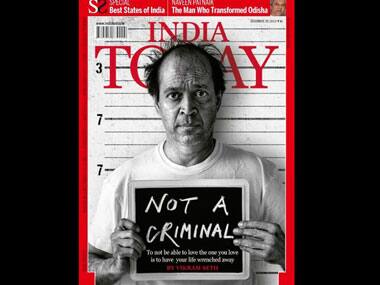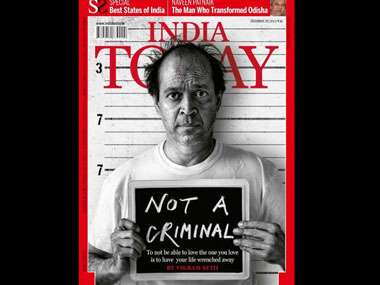Editor’s note: This is a reader comment we got in response to the article, “
When an issue becomes a brand: Vikram Seth and the Section 377 cover
”. As is Firstpost policy, we have lightly edited for grammar and spelling, but the comment has been left as is. by Rafiul Alom Rahman This is in response to Akshay Pathak’s article titled ‘When an issue becomes a brand: Vikram Seth and the Section 377 cover’, where he condemns Seth’s photo-shoot for India Today and points out the elitism of the queer movement. While I agree with Akshay Pathak that the fight against Section 377 has to strengthen itself with ‘’a more broad-based understanding towards a multitude of oppressions’’, I refuse to see Seth’s appearance on the cover of a mainstream magazine as nothing but a mere capitalist agenda to make an issue into a brand. I’m sure things are far from being so black and white. While Pathak raises other important concerns in his article and talks about the need for the queer movement to introspect, many critics from the Left have twisted that very argument to question the foundation of the queer movement. Over the past few days since the retrogressive judgement of the Supreme Court, they have been criticizing the queer movement. A Marxist filmmaker had written on Facebook saying how he found no error in the judgement and how the noise against 377 was a mere ‘capitalist brouhaha’. He went on to say, though he was critical of Section 377 of the IPC, he believed that the section in itself was not so widely used to harass the LGBTQ. [caption id=“attachment_1307883” align=“alignleft” width=“380”]
 India Today’s cover.[/caption] Like the Supreme Court, his argument dealt with numbers. How did the violation faced by only 200 people over decades matter? When I told him that the oppression faced by the queer community extended beyond 377, he was quick to call it ‘societal oppression’ rather than that of the state. According to him, only the hijras, transgenders and kotis in the lower rung of the society suffered while gay men and women all lived in a happy paradise. I told him that though the ‘’visibly queer’’ people were more at the receiving end of police/state violence, the very presence of a law like Section 377 validates the structural homophobia of the state and the society at large. When he couldn’t argue further, he insisted on how the Indian society was not ready to accept homosexuality by drawing an analogy with incest. Then he went on to say how there is little noise over other issues of oppression that deserved our attention, issues concerning Adivasis, Dalits and women. Since the day of the judgement, some so-called advocates of Dalit, Adivasi rights from the Left have been drawing a hierarchy of issues. According to them, issues concerning ‘roti, kapda, roads’ were more important than criminalization of one’s homosexuality. Then there were Kashmiri people who otherwise championed the cause of ‘azaadi’ but maintained a conspicuous silence on the judgement or made extremely derogatory and insensitive remarks on social media about the freedom of LGBTQ people. The administrator in a minority news forum, Beyond Headlines, wrote how Rahul Gandhi’s speaking against the judgement was hurting the “Muslim sentiment”. As if every Muslim on the street would turn ‘gay’ if Section 377 was repealed. With a hierarchy of issues, came the ‘hierarchy of pain’. Whose pain was greater – your or mine? And the conclusion was that the ‘noise’ around 377 was all part of the capitalist agenda and the queer movement was nothing but elitist. Why? Because people came out on the streets in urban centres and the liberal media voiced its concern. In a bid to critique the elitism of the queer movement many of these Left scholars/activists failed to see through their own hypocrisy. I still remember how the ‘elite’ queer group in Delhi had protested against the murder of transgender activist, Maria, who has suddenly become so dear to the critics of queer movement. Where were these activists then? For any movement to sustain itself, it has to engage with its critics. But to see the movement as a monolithic entity and criticize for the heck of it doesn’t cut ice anymore. The queer movement like any other movement has had its share of flaws but to reduce it to ‘corporate brouhaha’ is just unfair. A few days ago, I met Manohar Elevarthi, a bisexual man who is also the founding member of Praja Rajakiya Vedike, a group that has been part of several people’s movements like the fight against minority witch-hunting in Karnataka, and which also fielded the first transgender candidate, Veena in the state assembly elections. He informed me how the Karnataka Sexual Minorities Forum has been part of the Right to Food campaign and has been closely involved with the rural workers’ union, grakoos. It has also been part of people’s health movement, land rights movement and secular struggles in Karnataka among other things. It is important that while we criticize the queer movement, we also engage with it. This is the time when various movements could come together and make their voices heard against 377 instead of hiding behind their own moral prudishness. If our critique of the queer movement has to do with class, then let us fight together for a society where the LGBTQ is not demoralised, demeaned and dehumanized so that the gay rickshaw-puller whom I met some months ago didn’t have to tell me the horror story of a forced heterosexual marriage. Vikram Seth’s India Today cover would only inspire more people to break free from the closet doors of shame, abuse and silence.
India Today’s cover.[/caption] Like the Supreme Court, his argument dealt with numbers. How did the violation faced by only 200 people over decades matter? When I told him that the oppression faced by the queer community extended beyond 377, he was quick to call it ‘societal oppression’ rather than that of the state. According to him, only the hijras, transgenders and kotis in the lower rung of the society suffered while gay men and women all lived in a happy paradise. I told him that though the ‘’visibly queer’’ people were more at the receiving end of police/state violence, the very presence of a law like Section 377 validates the structural homophobia of the state and the society at large. When he couldn’t argue further, he insisted on how the Indian society was not ready to accept homosexuality by drawing an analogy with incest. Then he went on to say how there is little noise over other issues of oppression that deserved our attention, issues concerning Adivasis, Dalits and women. Since the day of the judgement, some so-called advocates of Dalit, Adivasi rights from the Left have been drawing a hierarchy of issues. According to them, issues concerning ‘roti, kapda, roads’ were more important than criminalization of one’s homosexuality. Then there were Kashmiri people who otherwise championed the cause of ‘azaadi’ but maintained a conspicuous silence on the judgement or made extremely derogatory and insensitive remarks on social media about the freedom of LGBTQ people. The administrator in a minority news forum, Beyond Headlines, wrote how Rahul Gandhi’s speaking against the judgement was hurting the “Muslim sentiment”. As if every Muslim on the street would turn ‘gay’ if Section 377 was repealed. With a hierarchy of issues, came the ‘hierarchy of pain’. Whose pain was greater – your or mine? And the conclusion was that the ‘noise’ around 377 was all part of the capitalist agenda and the queer movement was nothing but elitist. Why? Because people came out on the streets in urban centres and the liberal media voiced its concern. In a bid to critique the elitism of the queer movement many of these Left scholars/activists failed to see through their own hypocrisy. I still remember how the ‘elite’ queer group in Delhi had protested against the murder of transgender activist, Maria, who has suddenly become so dear to the critics of queer movement. Where were these activists then? For any movement to sustain itself, it has to engage with its critics. But to see the movement as a monolithic entity and criticize for the heck of it doesn’t cut ice anymore. The queer movement like any other movement has had its share of flaws but to reduce it to ‘corporate brouhaha’ is just unfair. A few days ago, I met Manohar Elevarthi, a bisexual man who is also the founding member of Praja Rajakiya Vedike, a group that has been part of several people’s movements like the fight against minority witch-hunting in Karnataka, and which also fielded the first transgender candidate, Veena in the state assembly elections. He informed me how the Karnataka Sexual Minorities Forum has been part of the Right to Food campaign and has been closely involved with the rural workers’ union, grakoos. It has also been part of people’s health movement, land rights movement and secular struggles in Karnataka among other things. It is important that while we criticize the queer movement, we also engage with it. This is the time when various movements could come together and make their voices heard against 377 instead of hiding behind their own moral prudishness. If our critique of the queer movement has to do with class, then let us fight together for a society where the LGBTQ is not demoralised, demeaned and dehumanized so that the gay rickshaw-puller whom I met some months ago didn’t have to tell me the horror story of a forced heterosexual marriage. Vikram Seth’s India Today cover would only inspire more people to break free from the closet doors of shame, abuse and silence.
India Today's Vikram Seth cover will help people break out of the closet
Firstpost Community
• December 26, 2013, 15:15:31 IST
It is important that while we criticize the queer movement, we also engage with it. This is the time when various movements could come together and make their voices heard against 377 instead of hiding behind their own moral prudishness.
Advertisement
)
End of Article